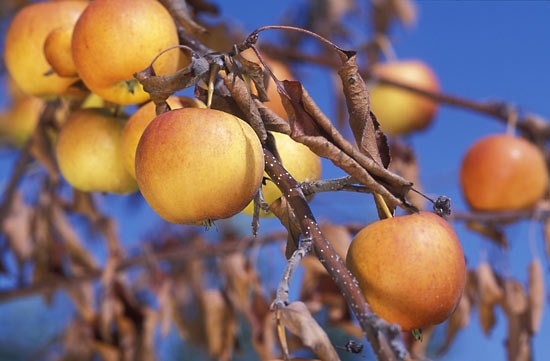blight
plant pathology
 any of various plant diseases whose symptoms include sudden and severe yellowing, browning, spotting, withering, or dying of leaves, flowers, fruit, stems, or the entire plant. Usually the shoots and other young, rapidly growing tissues of a plant are attacked. Most blights are caused by bacterial or fungal infestations, but they can also occur from drought. Fungal and bacterial blights are most apt to occur under cool, moist conditions. Most economically important plants are susceptible to one or more blights.
any of various plant diseases whose symptoms include sudden and severe yellowing, browning, spotting, withering, or dying of leaves, flowers, fruit, stems, or the entire plant. Usually the shoots and other young, rapidly growing tissues of a plant are attacked. Most blights are caused by bacterial or fungal infestations, but they can also occur from drought. Fungal and bacterial blights are most apt to occur under cool, moist conditions. Most economically important plants are susceptible to one or more blights.Measures for controlling and preventing blight typically involve the destruction of the infected plant parts; use of disease-free seed or stock and resistant varieties; crop rotation; pruning and spacing of plants for better air circulation; controlling pests that carry the fungus from plant to plant; avoidance of overhead watering and working among wet plants; and, where needed, the application of fungicide or antibiotics. Sanitation to stop the spread of the infestation is the cardinal measure. For bacterial blights (e.g., fire blight), fixed copper or streptomycin is an effective antibiotic when applied weekly during damp weather when leaves and shoots are expanding. See also botrytis blight; chestnut blight; fire blight; late blight.
- Juan María Bordaberry Arocena
- Juan Meléndez Valdés
- Juan Montalvo
- Juan Negrín López
- Juan O'Gorman
- Juan Pablo Bonet
- Juan Pablo Duarte
- Juan Pablo Forner
- Juan Padilla
- Juan Perón
- Juan Ponce de León
- Juan Prim
- Juan Ramón Jiménez
- Juan Rodríguez Cabrillo
- Juan Ruiz
- Juan Ruiz de Alarcón
- Juan Rulfo
- Juan Sebastián del Cano
- Juan Sánchez Cotán
- Juantorena, Alberto
- Juan T. Trippe
- Juan Valera y Alcalá Galiano
- Juan Velasco Alvarado
- Juan Vicente Gómez
- Juan Zorrilla de San Martín